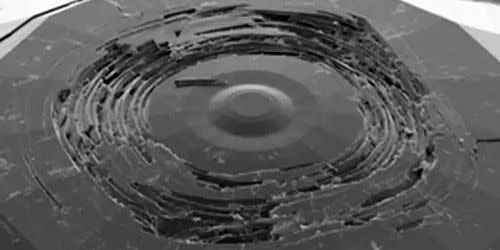Wait, Did Scientists Finally Create Metallic Hydrogen?

French scientists believe they have made metallic hydrogen using special torus-shaped diamond anvils.
Groups around the world have worked on the metallic hydrogen problem for years.
These results are important, but scaling them up will be hugely difficult.
Scientists have used diamond anvils to compress hydrogen into a form they believe is metallic. In Nature, researchers from the French Alternative Energies and Atomic Energy Commission (CEA) describe how their hydrogen sample changed into a form that acts like a metal.
The same researchers have been working toward metallic hydrogen for years. From the military department of the CEA, they first put this study online in September. After peer review, the study is now ready for prime time in Nature. In it, the scientists describe sealing supercooled solid hydrogen in foil to prevent escape and then bombarding it with extremely high pressure using a diamond anvil cell.
In previous, similar experiments, pressure was limited to about 400 gigapascals. With the recent development of a different shaped diamond anvil, which is a torus or donut instead of a flat surface, scientists can apply more pressure. It’s in this next zone, at 425 gigapascals, that the French research team observed the first metallic properties.
The researchers emphasize that both the cooling and the pressure are critical to inducing this state change. “Under increasingly extreme pressures, dense hydrogen becomes more and more opaque to visible light,” the researchers write, where “dense hydrogen” means the very cold solid sample. Then, at 425 gigapascals, the opaque hydrogen becomes shiny and reflective.
There are limitations to even this very promising research. Measuring any qualities in such a tiny sample and under such extreme conditions is difficult, and that precludes clear and conclusive chromatographic measurements as well as the critical test of electrical conductivity. Different groups have claimed to have made metallic hydrogen over the years, and scientists first speculated that it could exist way back in the 1930s.
Why is metallic hydrogen such a scientific holy grail? Well, the potential uses for hydrogen in general are widened if there’s a metallic form that scientists can access, and in the race for metallic hydrogen, the race itself is something of a grail quest for scientific bragging rights. The combination of extreme-enough pressure and extreme-enough cold likely doesn’t exist anywhere in the universe, which makes metallic hydrogen an even more attractive goal.
Even if there’s a natural environment somewhere in the universe, recreating the conditions on Earth is a huge challenge, including measuring the results to confirm them. Once there’s a reliable and fairly stable form of metallic hydrogen, it could replace much heavier metals and become what NASA calls a “game changing rocket propellant.” In that 2011 release, a scientist proposed doctoring solid hydrogen to help scientists induce a metallic phase change with less pressure.
The quest for a stable metallic hydrogen will likely continue for decades, but the work of this French research team is potentially a huge landmark along the way. Now if we could just confirm this metallic hydrogen is conductive and indeed metallic, produce it in much, much larger quantities, and find a way for it to be stable at normal temperature and pressure, we’ll be all set.
You Might Also Like
